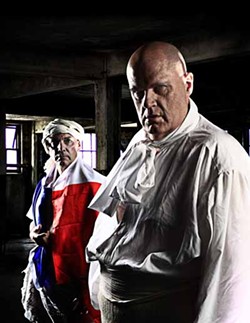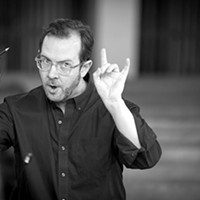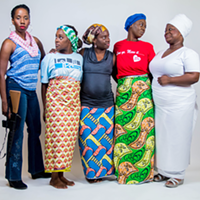It's been over 20 years since Marat/Sade has been staged in Charlotte. Part of the long-extinct Experimental Theatre Project, that Marat/Sade was rather barebones, staged in the Discovery Place lecture hall. My most vivid memories of the show are the trepidations I felt in bringing my daughter to see it.
My worries were groundless. She loved it! For years afterwards, the production served as a kind of passport: When people would question whether it was prudent to bring Ilana to a heavy, bawdy, or scatological spectacle, I'd simply say that she enjoyed Marat/Sade at the age of 8, and the questioner would be silenced.
Truth was, Marat/Sade had bored me. Aside from the guitar and Citizen Marat seated in his bathtub, all I remembered about the Peter Weiss play was contained in its full title, The Persecution and Assassination of Jean-Paul Marat as Performed by the Inmates of the Asylum at Charenton Under the Direction of the Marquis de Sade. Fair to say my expectations weren't sky high when it opened last week at Carolina Actors Studio Theatre.
Wrong again. This production, devilishly directed by Charles LaBorde, who co-stars as de Sade, is stunning -- a visceral assault on your intellectual jugular.
When you enter the outer lobby at 1118 Clement Ave., you reach through a petite mademoiselle guillotine to retrieve your ticket, a beheaded little doll representing the harvest of the Reign of Terror. Further inside, the simulations of the asylum become abruptly life-size. Makes sense. If the play is to be performed by inmates, why not have inmates do the ushering?
The set by Robert Lee Simmons is cunningly surrounded by railing on the three sides of the set where we, the invited guests of the asylum, are to sit. A telling suggestion that we need protection, n'est-ce pas? This "bathhouse theatre" is already populated by many of the caged residents of the Charenton facility as we enter. Their costuming (by Barbara Wesselman), and that of asylum director Francois de Coulmier, will likely put you in mind of Les Miserables. But it's the three-person makeup team of Lauren Crozier, Cindy Kistenberg and Michael Simmons who put the crowning visual touches on the pallor -- and the horror -- of the inmates.
Simmons plays Marat, and he's the only significant blemish on this production. Rather impressive when you consider that the company totals nearly 30 actors who mostly simulate demented inmates, brutal keepers and the odd nun with little in the way of speaking roles.
Yes, Weiss's drama is a play within a play, but it's also a revolt within a revolt, with insane actors portraying a French Revolution that went insane -- in a de Sade script that has unsettling tendencies toward derailing and escalating from defiance to madness. Our "persecution" here is de Sade's indictment of Marat's bloodthirsty zealotry back in 1793 when he was assassinated by Charlotte Corday, but in the here-and-now of the 1808 performance, the crosshairs of de Sade's scorn turn toward Coulmier and the current regime that has committed him to this snake pit.
LaBorde epitomizes the cynical, violence-obsessed voluptuary whether he's coming on to Courmier's wife, reveling in a masochistic whipping, or debunking Marat's lofty orations. It's added lagniappe that he's also the director here portraying a director. As Charlotte Corday, Karina Roberts-Caparino receives de Sade's tenderest directions. The narcoleptic nymph needs it! We can also see why she also kindles the passion of the sex maniac inmate who plays Duperret, Corday's convicted co-conspirator. Roberts-Caparino doesn't fall for Duperret's overtures, though Michael Sharpe's eyes perpetually gleam with the lust protruding from his crotch, but the actress demonstrates an extraordinary aptitude for falling asleep in the middle of a sentence.
A couple of other fascinating inmates loom at the periphery. Amanda Nicastro is the trembling, stammering inmate who is pitiably unable to portray Simonne Evrard, Marat's common law wife, and Scott McCalmont makes a devastating debut as the Herald, often stepping in to narrate de Sade's play with a sharp edge of cruelty and cheerful condescension.
There's no guitar, but there is an eerie quartet singing a suite of songs written by Richard Peaslee that director Peter Brook appended to the Adrian Mitchell-Geoffrey Skelton adaptation of the original German script. Alex Mauldin has composed new music for the songs, which aren't exactly folksy. The quartet and the Herald are the most emphatic reminders of something I'd long forgotten about Weiss's script: It's written in rhyming verse!
Amid all this excellence, it's hard to diagnose where Simmons goes astray as Marat. At times, he just seems stuck back in Glengarry Glen Ross; at others, he seems lost in the layers of his role, unable to find or define the inmate who is impersonating Marat.
So it's fortunate that Marat's assassination isn't the culmination of Weiss's -- or LaBorde's -- design. No, the real climax reminds us that there are occasions when theater can plausibly wield noise as a horrifying weapon, times when it's plausible for a drama to reach rock concert decibels with the same visceral, ground-shaking results.
Marat/Sade definitely rocks. Be ready to roll with it.
I have now seen New Kid three or four times in Children's Theatre productions, but the current Tarradiddle Players is far more emotionally gripping and funnier than any of those I've seen before. The chief reason is Salvador Garcia's portrayal of Nick, the Homelander who must brave the difficulties of acclimating to American life. He could be the best thing that's happened to Tarradiddle in a while -- or it may be the way around. Stephen Seay, who plays Mug, the bigoted bully who plagues Nick, is certainly the better for his Tarradiddling.
Matt Cosper directs sharply, refusing to blunt the comedy, the meanness, or the hurt. English is turned into an encoded gobbledygook in Dennis Foon's script that Cosper has fun refreshing, so Wayne Gretzky is no longer in that intermittently intelligible language. Darlene Black is Nick's mom, and Leslie Ann Giles is Mencha, the plucky schoolgirl who welcomes the stranger. Both are perfection.
Latest in Performing Arts
More by Perry Tannenbaum
Calendar
-

WHISKEY TASTING: VIRGINIA HIGHLANDS WHISKY @ Elizabeth Parlour Room
-

NEW WINDOW GALLERY-Pat Rhea-ACRYLIC PAINTINGS-April 05-30 2024 VALDESE, NC 28690 @ New Window Gallery/Play It Again Records
- Through April 30, 12 p.m.
-
An Evening With Phil Rosenthal Of "Somebody Feed Phil" @ Knight Theater
-
Kountry Wayne: The King Of Hearts Tour @ Ovens Auditorium
-

Trap & Paint + Karaoke @ Zodiac Bar & Grill
-
Halloween Guide 2016
31 spooktacular things to do in the Q.C.
-
Jessica Moss Makes the Gantt Center a Safe Zone for Local Artists 2
Flipping the script
-
Halo 4 earns critical hallelujahs
Plus, news on Mass Effect Trilogy, LEGO: The Lord of the Rings















